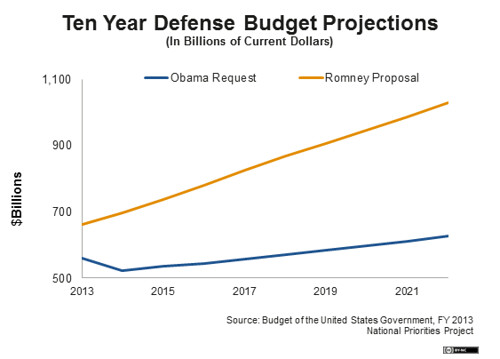Pentagon Spending: Obama vs. Romney
By
Chris Hellman
Posted:
|
Budget Process,
Military & Security
During Monday’s presidential debate both candidates discussed their plans for future Pentagon spending. Gov. Romney claimed that President Obama would cut $1 trillion from the Pentagon’s budget, while President Obama questioned how Gov. Romney would fund $2 trillion in new Pentagon spending.
So what’s going on here? Let’s look at some numbers.
As part of his fiscal year 2013 budget request, President Obama proposed a 2.5 percent decrease in the Pentagon’s annual “base” budget – meaning the military budget excluding war costs and a few other things. This minimal decrease would be the first reduction in the Pentagon’s budget since the terrorist attacks of Sept. 11, 2001. Yet as President Obama indicated at a Jan. 5, 2012, press briefing at the Pentagon, "Over the next 10 years, the growth in the defense budget will slow, but the fact of the matter is this: It will still grow..."
For his part, Gov. Romney has stated that he would support a floor for annual Pentagon spending that is tied to gross domestic product (GDP). According to his election website, “Mitt Romney will begin by reversing Obama-era defense cuts … with the goal of setting core defense spending (i.e. not including war costs)… at a floor of 4 percent of GDP.”
So how do the two candidates' plans compare?
As the chart below shows, President Obama’s plan reduces Pentagon spending in the first year, and then projects modest growth after that. Gov. Romney’s budget, based on GDP projections from the Office of Management and Budget (OMB), would be much higher in FY2013, and then grow significantly over the next decade.

Looking at just FY2013, at 4 percent of GDP Gov. Romney’s plan would equal a Pentagon budget of roughly $661 billion dollars. This is $136 billion more than the $525 billion requested by President Obama, an increase of over 25 percent.
Over the next ten years, Gov. Romney’s plan would call for total Pentagon spending of $8.4 trillion, while President Obama’s plan would result in total spending of $5.7 trillion, a difference of 48 percent.